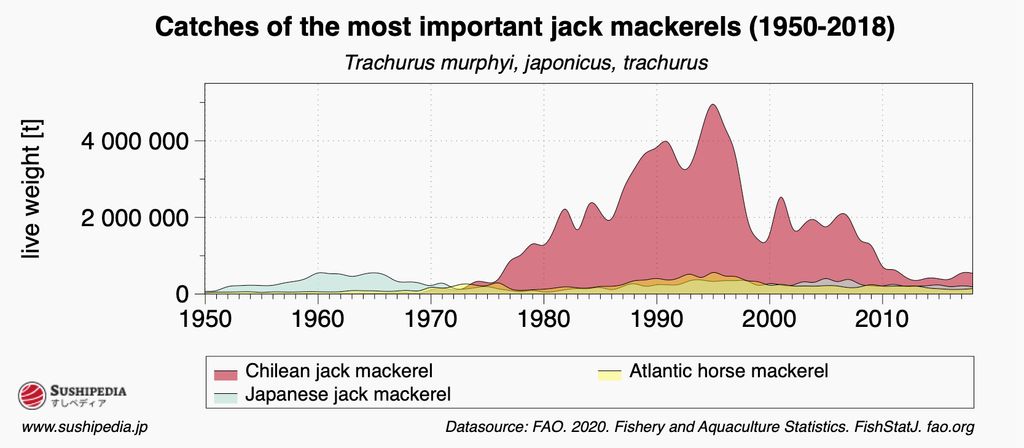Chiri Maaji Sushi
A Comprehensive Overview of Chilean Jack Mackerel in Japanese Sushi Cuisine
チリマアジすし 
What is Chiri Maaji?
Since the 1970s, the Chilean jack mackerel (chiri maaji) developed into one of the most important commercial fish species in the world. It is closely related to the Japanese horse mackerel (maaji), so this species is also considered by the Japanese as “real or genuine mackerel” and therefore has the name “Chilean genuine mackerel” (chiri-ma-aji) in Japanese. Chiri maaji and maaji both belong to the genus of Jack mackerels or saurels (Trachurus), which are known as aji in Japanese.
Chiri Maaji for Sushi or Sashimi
The meat is very tender, cloudy white to light pink and fatty, regardless of its freshness .[1] Especially fresh specimens have a more subtle taste. Besides being prepared as sushi or sashimi, it is a more popular dish when grilled or otherwise cooked. Mackerel in generall (aji) is very popular in Japan and considered as particularly healthy because of its rich omega-3 fatty acid content. Chiri maaji sushi is usually served with freshly grated ginger and Japanese bunching onion.
This fish is more common as a sushi ingredient in inexpensive sushi restaurants. Within Japan or in upscale sushi restaurants, preference is given to the Japanese horse mackerel or the Atlantic horse mackerel (nishimaaji).
Chiri Maaji Trivia
In the 1990s, Chilean jack mackerel (chiri maaji) played an important role in surimi production, but due to declining catches and changing economic conditions, it has become less important.[2]
Characteristics & Ecology of Chiri Maaji
Chilean jack mackerel (chiri maaji) are schooling fish that can be found on coasts as well as in the open ocean. They usually swim in depths between 10 and 70 m, occasionally they can reach depths of up to 300 m. Their distribution extends from the South Pacific over the southwest Atlantic to the eastern Central and South Pacific. They feed mainly on fish larvae and small crustaceans. This species can live up to 16 years. As for themselves, they serve as a source of food for tuna and swordfish. For industrial aquaculture, they are often processed into fish meal and used as feed.
As a migratory species, they migrate north in the summer months and return south when the sea temperature begins to fall. The northern stock spawns in summer, while the southern stock has its main spawning season in November to January. They are caught using trawls, longlines, purse seines, pots, and netting.
Economy of Chiri Maaji

SushiPedia. Catch Volumes Mackerel. All rights reserved ©
The Jack mackerels, horse mackerel or saurels (Trachurus spp.) play a significant role in the global fishing industry, as evidenced by the catches recorded over a long period from 1950 to 2018. In particular, the catches of Chilean jack mackerel paint a dramatic picture of fishing that begins in the 1970s and peaks in the late 1980s. This increase could be attributed to the development of new fishing techniques and vessels and the expansion of fishing areas. The decline after this peak could be due to overfished stocks or the introduction of stricter fishing quotas, underlining the need for sustainable management of marine resources.
In contrast, catches of Japanese horse mackerel and Atlantic jack mackerel show significant consistency, which could indicate more sustainable fishing practices or lower demand. This stability in catches is crucial for the maintenance of marine ecosystems as it helps to maintain the balance between human needs and biodiversity conservation.
According to Food and Agriculture Organization of the United Nations (FAO) Statistics, the total catch of Chilean jack mackerel (chiri maaji) in 2017 was 544 803 tonnes worldwide, making it the most heavily fished representative of its species. The Japanese horse mackerel (maaji), on the other hand, accounts for a total catch of 211 459 tonnes.
Season Calendar for Chiri Maaji
The calendar shown does not provide information on fishing times, but marks the periods in which chiri maaji is considered particularly tasty.
Warnings related to Chiri Maaji
Species of Chiri Maaji
The following species are regarded as authentic chiri maaji. Either historically, according to the area of distribution or according to the common practice in today's gastronomy:
Sources and Further Reading
- [1]Kenichi Miyamoto. 『チリマアジ Murphy's mackerel』. fishguide.co.nz. Source retrieved 12/27/2021
- [2]Jae W. Park. Surimi and Surimi Seafood. CRC Press, Boca Raton. 2013
- [3]Fish and Fishery Products Hazards and Controls Guidance. U.S. Department of Health and Human Services Food and Drug Administration Center for Food Safety and Applied Nutrition. 2020
- Rainer Froese, Pauly Daniel. FishBase. The Leibniz Institute of Marine Sciences at the University of Kiel, FishBase.org, 2019. Source retrieved 12/24/2020
- Fishery and Aquaculture Statistics, Statistiques des pêches et de l’aquaculture, Estadísticas de pesca y acuicultura 2017. Food and Agriculture Organization of the United Nations (FAO), Rome. 2019
- IUCN Red List of Threatened Species. Version 2023-1
Image Credits
- SushiPedia. Aji Sushi Nigiri. All rights reserved ©
- SushiPedia. Catch Volumes Mackerel. All rights reserved ©